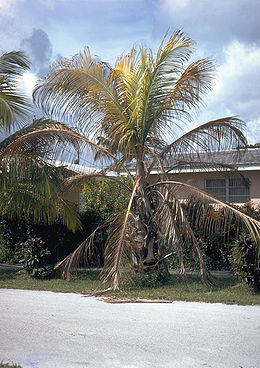
Lethal yellowing
Encyclopedia

Phytoplasma
Phytoplasma are specialised bacteria that are obligate parasites of plant phloem tissue and transmitting insects . They were first discovered by scientists in 1967 and were named mycoplasma-like organisms or MLOs. They cannot be cultured in vitro in cell-free media...
disease that attacks many species of palms
Arecaceae
Arecaceae or Palmae , are a family of flowering plants, the only family in the monocot order Arecales. There are roughly 202 currently known genera with around 2600 species, most of which are restricted to tropical, subtropical, and warm temperate climates...
, including some commercially important species such as the Coconut
Coconut
The coconut palm, Cocos nucifera, is a member of the family Arecaceae . It is the only accepted species in the genus Cocos. The term coconut can refer to the entire coconut palm, the seed, or the fruit, which is not a botanical nut. The spelling cocoanut is an old-fashioned form of the word...
and Date Palm
Date Palm
The date palm is a palm in the genus Phoenix, cultivated for its edible sweet fruit. Although its place of origin is unknown because of long cultivation, it probably originated from lands around the Persian Gulf. It is a medium-sized plant, 15–25 m tall, growing singly or forming a clump with...
. It is spread by the planthopper Haplaxius crudus (former name Myndus crudus) which is native to Florida, parts of the Caribbean and Central America. Infected plants will normally die in 3 to 6 months. The only effective cure is prevention, i.e. planting resistant varieties of coconut palm and preventing a park or 'golf course like' environments which attracts the planthopper. Some cultivars, such as the Panama Tall coconut cultivar nearly died out by lethal yellowing. Heavy turf grasses and similar green ground cover will attract the planthopper to lay its eggs and the nymphs develop at the roots of these grasses. The planthpoppers eggs and nymphs may pose a great threat to coconut growing countrys economies, into which grass seeds for golf course
Golf course
A golf course comprises a series of holes, each consisting of a teeing ground, fairway, rough and other hazards, and a green with a flagstick and cup, all designed for the game of golf. A standard round of golf consists of playing 18 holes, thus most golf courses have this number of holes...
s and lawns are imported from the Americas. It is not clearly understood how the disease was spread to East Africa
East Africa
East Africa or Eastern Africa is the easterly region of the African continent, variably defined by geography or geopolitics. In the UN scheme of geographic regions, 19 territories constitute Eastern Africa:...
as the planthopper haplaxius crudus is not native in East Africa.
The only explantion is that it was imported with grass seed from Florida that were used to create golf courses and lawns in beach resorts. There is a direct connection between green lawns and the spread of lethal yellowing in Florida. Even so called 'resistant cultivars' such as 'maypan cultivar' do not have a 100% immunity.The nymphs of the planthoppers develop on roots of grasses, hence the areas of grass in the vicinity of palm trees is connected with the spread of this phytoplasma
Phytoplasma
Phytoplasma are specialised bacteria that are obligate parasites of plant phloem tissue and transmitting insects . They were first discovered by scientists in 1967 and were named mycoplasma-like organisms or MLOs. They cannot be cultured in vitro in cell-free media...
disease. The problem arose as a direct result of using coconut and date palms for ornamental and landscaping purposes in lawns, golf courses and gardens together with these grasses. When these two important food palms where grown in traditional ways (without grasses) in plantations and along the shores, the palm grooves weren't noticebly affected by lethal yellowing. The disease can also be spread by poor phytosanitary gardening and trimming techniques, when instruments used to cut an infected palm are then used to cut or trim a healthy one. Treating the knives or gardening scissors using a disinfectant (Lysol
Lysol
Lysol is a trade name for common household cleanersLysol may also refer to:* Lysol , a 1992 album by The Melvins* Lysol , Actor muMs da Schemer played Lysol in The Mad Real World skit on Chappelle's Show....
) or by dipping them in boiling water for some time is suggested as a precaution before and after cutting any palms.

